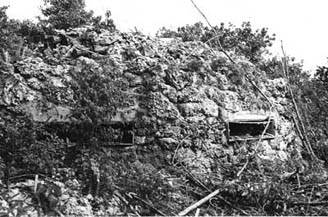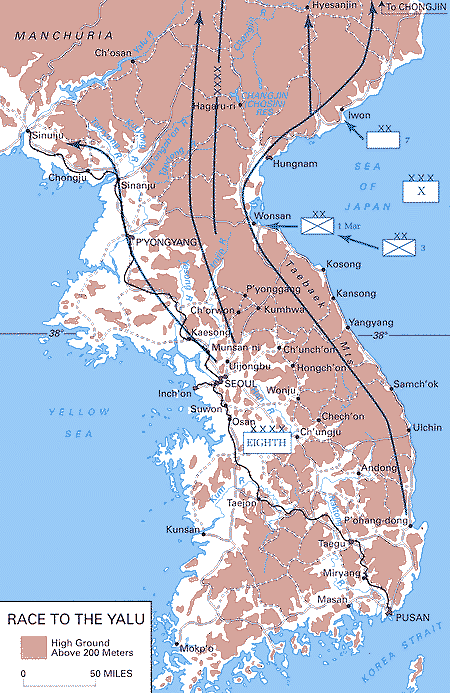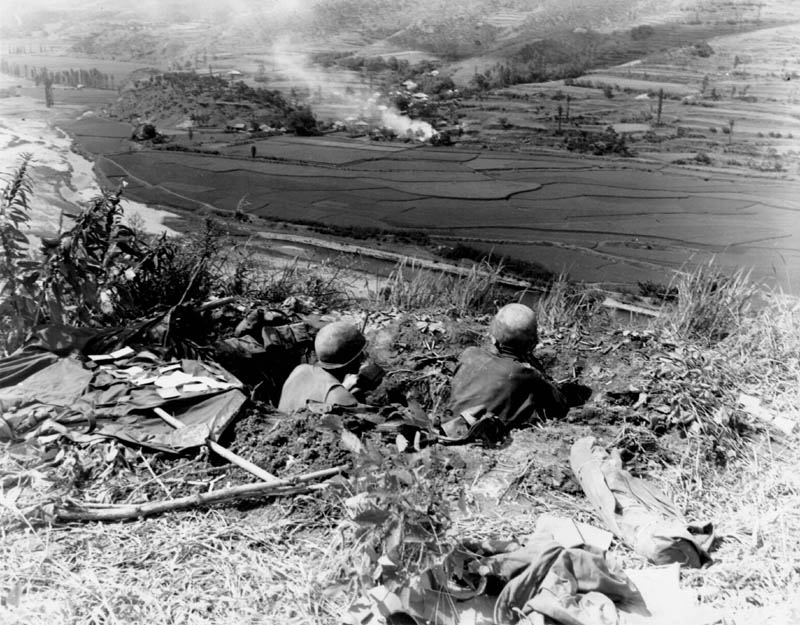|
1st Marine Division (United States)
The 1st Marine Division (1st MARDIV) is a Marine division of the United States Marine Corps headquartered at Marine Corps Base Camp Pendleton, California. It is the ground combat element of the I Marine Expeditionary Force (I MEF). It is the oldest and largest active duty division in the United States Marine Corps, representing a combat-ready force of more than 19,000 personnel. It is one of three active duty divisions in the Marine Corps today and is a multi-role, expeditionary ground combat force. It is nicknamed "The Old Breed". Mission The division is employed as the ground combat element (GCE) of the I Marine Expeditionary Force or may provide task-organized forces for assault operations and such operations as may be directed. The 1st Marine Division must be able to provide the ground amphibious forcible entry capability to the naval expeditionary force (NEF) and to conduct subsequent land operations in any operational environment.. Accessed 9 June 2009. 10 June 2009 ... [...More Info...] [...Related Items...] OR: [Wikipedia] [Google] [Baidu] |
Battle Of Peleliu
The Battle of Peleliu, codenamed Operation Stalemate II by the US military, was fought between the United States and Japan during the Mariana and Palau Islands campaign of World War II, from September 15 to November 27, 1944, on the island of Peleliu. US Marines of the 1st Marine Division and then soldiers of the US Army's 81st Infantry Division, fought to capture an airfield on the small coral island of Peleliu. The battle was part of a larger offensive campaign known as Operation Forager, which ran from June to November 1944 in the Pacific Theater. Major General William Rupertus, the commander of the 1st Marine Division, predicted that the island would be secured within four days. However, after repeated Imperial Japanese Army defeats in previous island campaigns, Japan had developed new island-defense tactics and well-crafted fortifications, which allowed stiff resistance and extended the battle to more than two months. The heavily-outnumbered Japanese defenders put up su ... [...More Info...] [...Related Items...] OR: [Wikipedia] [Google] [Baidu] |
First Battle Of The Hook
The First Battle of the Hook was a battle fought between 2 and 28 October 1952 during the Korean War between United Nations Command (UN) and Chinese forces over several frontline outposts. Background In March 1952 the US 1st Marine Division was transferred to US I Corps and moved onto the Jamestown Line, the UN's Main line of resistance (MLR) across Korea. The segment of the Jamestown Line assigned to the 1st Marine Division extended southwest from the Samichon River and the left flank of the British 1st Commonwealth Division, crossed the 38th Parallel (the original demarcation between North and South Korea) shifted to the south bank of the Imjin River in the vicinity of Munsan-ni, continued to the conflux of the Imjin and Han River, and then followed the south bank of the Han past the Kimpo Peninsula. Opposing the Marines on the Jamestown Line, the Chinese People's Volunteer Army (PVA) had the 65th and 63rd Armies, totaling 49,800 troops. The 7th Marine Regiment took ove ... [...More Info...] [...Related Items...] OR: [Wikipedia] [Google] [Baidu] |
Battle Of Bunker Hill (1952)
The Battle of Bunker Hill was a battle fought between 9 August and 30 September 1952 during the Korean War between United Nations Command (UN) and Chinese forces over several frontline outposts. Background In March 1952 the US 1st Marine Division (United States), 1st Marine Division was transferred to US I Corps (United States), I Corps and moved onto the Jamestown Line, the UN's Main line of resistance (MLR) across Korea. The segment of the Jamestown Line assigned to the 1st Marine Division extended southwest from the Samichon River and the left flank of the British 1st Commonwealth Division, crossed the 38th parallel north, 38th Parallel (the original demarcation between North and South Korea) shifted to the south bank of the Imjin River in the vicinity of Munsan-ni, continued to the conflux of the Imjin and Han River (Korea), Han River, and then followed the south bank of the Han past the Kimpo Peninsula. Opposing the Marines on the Jamestown Line, the Chinese People's Volun ... [...More Info...] [...Related Items...] OR: [Wikipedia] [Google] [Baidu] |
Battle Of The Punchbowl
The Battle of the Punchbowl ( ko, 펀치볼 전투), was one of the last battles of the movement phase of the Korean War. Following the breakdown of armistice negotiations in August 1951, the United Nations Command (UN) decided to launch a limited offensive in the late summer/early autumn to shorten and straighten sections of their lines, acquire better defensive terrain, and deny the enemy key vantage points from which they could observe and target UN positions. The Battle of Bloody Ridge took place west of the Punchbowl from August–September 1951 and this was followed by the Battle of Heartbreak Ridge northwest of the Punchbowl from September–October 1951. At the end of the UN offensive in October 1951, UN forces controlled the line of hills north of the Punchbowl. Prelude The Chinese People's Volunteer Army (PVA) Spring Offensive was stopped by 20 May 1951 and UN forces counterattacked forcing the PVA back to ''Line Kansas'' along the southern edge of the Punchbowl by 2 ... [...More Info...] [...Related Items...] OR: [Wikipedia] [Google] [Baidu] |
Battle Of Hwacheon
The Battle of Hwacheon was a battle fought between 22 and 26 April 1951 during the Korean War between United Nations Command (UN) and Chinese forces during the Chinese Spring Offensive. The US 1st Marine Division successfully defended their positions and then withdrew under fire to the ''No-Name Line''. Background In mid-April 1951 UN forces in the central front in Korea were engaged in Operation Dauntless to advance UN positions from the ''Kansas Line'' north of the 38th Parallel to positions north of the 38th Parallel designated the ''Wyoming Line'' which would threaten the Chinese People's Volunteer Army (PVA) and North Korean Korean People's Army (KPA) logistics hub marked out by the towns of Pyonggang, Ch'orwon and Kumhwa named the Iron Triangle. The advance by US I and IX Corps was to menace the Triangle, not invest it and if struck by strong enemy attacks during or after the advance, the two Corps were to return to the ''Kansas Line''. US Eighth Army intelligenc ... [...More Info...] [...Related Items...] OR: [Wikipedia] [Google] [Baidu] |
First And Second Battles Of Wonju
The First and Second Battles of Wonju (french: Bataille de Wonju), also known as the Wonju Campaign or the Third Phase Campaign Eastern SectorThe Western Sector is the Third Battle of Seoul. (), was a series of engagements between North Korean and United Nations (UN) forces during the Korean War. The battle took place from December 31, 1950 to January 20, 1951 around the South Korean town of Wonju. In coordination with the Chinese capture of Seoul on the western front, the North Korean Korean People's Army (KPA) attempted to capture Wonju in an effort to destabilize the UN defenses along the central and the eastern fronts. After a joint Chinese People's Volunteer Army (PVA) and KPA assault breached the UN defenses at Chuncheon on New Year's Eve of 1951, KPA V Corps attacked US X Corps at Wonju while KPA II Corps harassed US X Corps' rear by engaging in guerrilla warfare. In response, US X Corps under the command of Major General Edward Almond managed to cripple the KPA forces a ... [...More Info...] [...Related Items...] OR: [Wikipedia] [Google] [Baidu] |
Battle Of Chosin Reservoir
The Battle of Chosin Reservoir, also known as the Chosin Reservoir Campaign or the Battle of Lake Changjin (), was an important battle in the Korean War. The name "Chosin" is derived from the Japanese pronunciation "''Chōshin'', instead of the Korean pronunciation. The battle took place about a month after the People's Republic of China entered the conflict and sent the People's Volunteer Army (PVA) 9th Army to infiltrate the northeastern part of North Korea. On 27 November 1950, the Chinese force surprised the US X Corps commanded by Major General Edward Almond in the Chosin Reservoir area. A brutal 17-day battle in freezing weather soon followed. Between 27 November and 13 December, 30,000 United Nations Command troops (later nicknamed "The Chosin Few") under the field command of Major General Oliver P. Smith were encircled and attacked by about 120,000 Chinese troops under the command of Song Shilun, who had been ordered by Mao Zedong to destroy the UN forces. ... [...More Info...] [...Related Items...] OR: [Wikipedia] [Google] [Baidu] |
Second Battle Of Seoul
The Second Battle of Seoul was a battle that resulted in United Nations forces recapturing Seoul from the North Koreans in late September 1950. Approaching Seoul Before the battle, North Korea had just one understrength division in the city, with the majority of its forces south of the capital. MacArthur personally oversaw the 1st Marine Regiment as it fought through North Korean positions on the road to Seoul. Control of Operation Chromite was then given to Major General Edward Almond, the X Corps commander. General Almond was in an enormous hurry to capture Seoul by September 25, exactly three months after the North Korean assault across the 38th parallel. The advance on Seoul was slow and bloody after the landings at Inchon. The reason was the appearance in the Seoul area of two first-class fighting units of the Korean People's Army (KPA), the 78th Independent Infantry Regiment and 25th Infantry Brigade, about 7,000 troops in all. The KPA launched a T-34 attack, whic ... [...More Info...] [...Related Items...] OR: [Wikipedia] [Google] [Baidu] |
Battle Of Inchon
The Battle of Incheon (), also spelled Battle of Inchon, was an amphibious invasion and a battle of the Korean War that resulted in a decisive victory and strategic reversal in favor of the United Nations Command (UN). The operation involved some 75,000 troops and 261 naval vessels and led to the recapture of the South Korean capital of Seoul two weeks later. The code name for the operation was Operation Chromite. The battle began on 15 September 1950 and ended on 19 September. Through a surprise amphibious assault far from the Pusan Perimeter that UN and Republic of Korea Army (ROK) forces were desperately defending, the largely undefended city of Incheon was secured after being bombed by UN forces. The battle ended a string of victories by the North Korean Korean People's Army (KPA). The subsequent UN recapture of Seoul partially severed the KPA's supply lines in South Korea. The UN and ROK forces were commanded by General of the Army Douglas MacArthur of the United States ... [...More Info...] [...Related Items...] OR: [Wikipedia] [Google] [Baidu] |
Battle Of Pusan Perimeter
The Battle of the Pusan Perimeter ( ko, 부산 교두보 전투) was a large-scale battle between United Nations Command (UN) and North Korean forces lasting from August 4 to September 18, 1950. It was one of the first major engagements of the Korean War. An army of 140,000 UN troops, having been pushed to the brink of defeat, were rallied to make a final stand against the invading Korean People's Army (KPA), 98,000 men strong. UN forces, having been repeatedly defeated by the advancing KPA, were forced back to the "Pusan Perimeter", a defensive line around an area on the southeastern tip of South Korea that included the port of Busan. The UN troops, consisting mostly of forces from the Republic of Korea Army (ROKA), United States, and United Kingdom, mounted a last stand around the perimeter, fighting off repeated KPA attacks for six weeks as they were engaged around the cities of Taegu, Masan, and Pohang and the Naktong River. The massive KPA assaults were unsuccessful in for ... [...More Info...] [...Related Items...] OR: [Wikipedia] [Google] [Baidu] |
Korean War
, date = {{Ubl, 25 June 1950 – 27 July 1953 (''de facto'')({{Age in years, months, weeks and days, month1=6, day1=25, year1=1950, month2=7, day2=27, year2=1953), 25 June 1950 – present (''de jure'')({{Age in years, months, weeks and days, month1=6, day1=25, year1=1950) , place = Korean Peninsula, Yellow Sea, Sea of Japan, Korea Strait, China–North Korea border , territory = Korean Demilitarized Zone established * North Korea gains the city of Kaesong, but loses a net total of {{Convert, 1506, sqmi, km2, abbr=on, order=flip, including the city of Sokcho, to South Korea. , result = Inconclusive , combatant1 = {{Flag, First Republic of Korea, name=South Korea, 1949, size=23px , combatant1a = {{Plainlist , * {{Flagicon, United Nations, size=23px United Nations Command, United Nations{{Refn , name = nbUNforces , group = lower-alpha , On 9 July 1951 troop constituents were: US: 70.4%, ROK: 23.3% other UNC: 6.3%{{Cite ... [...More Info...] [...Related Items...] OR: [Wikipedia] [Google] [Baidu] |





